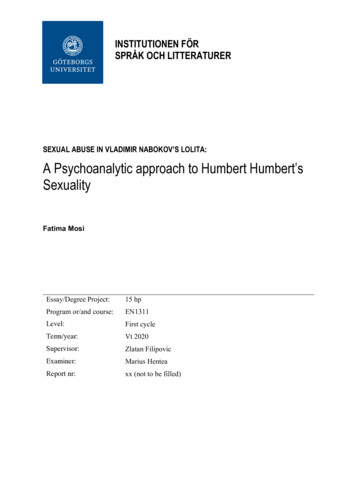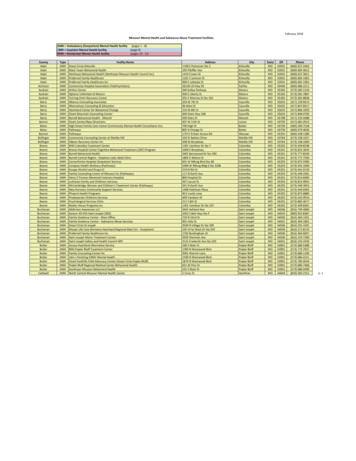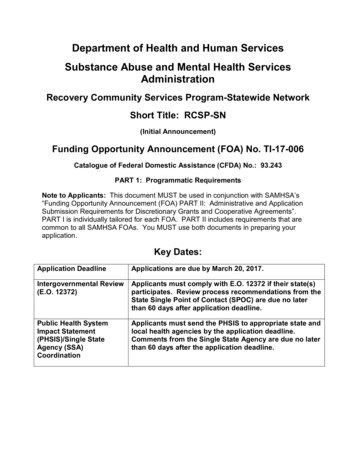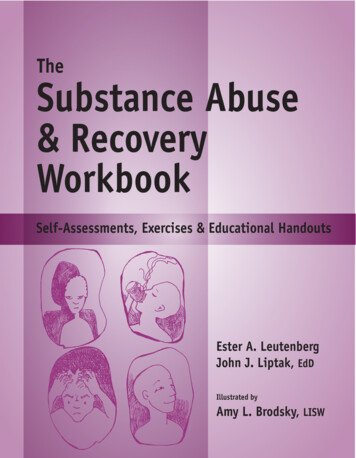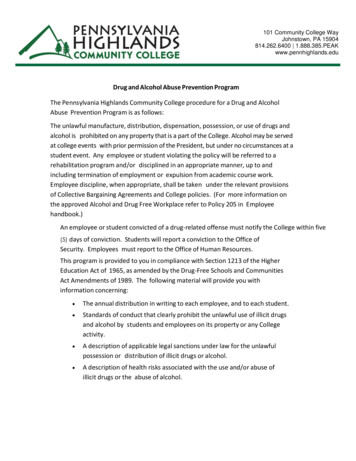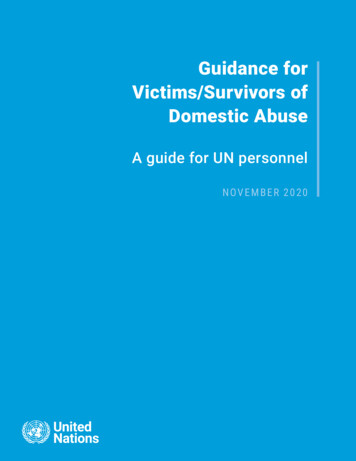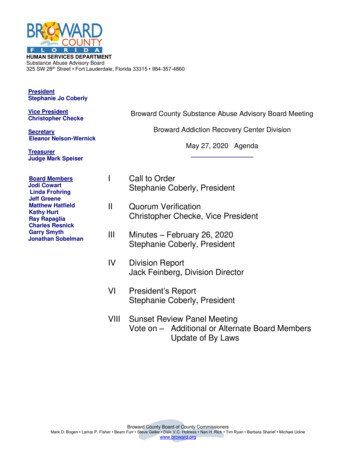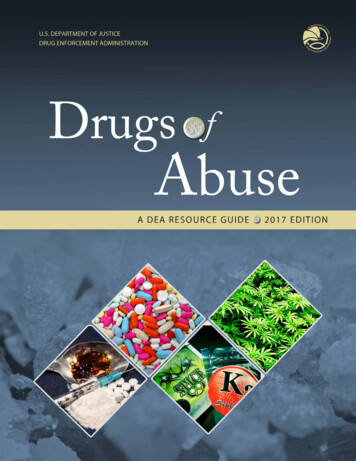
Transcription
Drugs of AbuseA DEA RESOURCE GUIDEPRODUCED AND PUBLISHED BYDrug Enforcement Administration U.S. Department of JusticeWWW.DEA.GOV
ContentsWelcome . 7VI. Depressants . 56I. Controlled Substances Act . 8Barbiturates .58Drug Scheduling .15Benzodiazepines .59Schedule I .15GHB.60Schedule II .22Rohypnol.62Schedule III .24VII. Hallucinogens . 64Schedule IV.27Ecstasy/MDMA .66Schedule V.29Ketamine .68Federal Trafficking Penalties .30LSD .70Federal Trafficking Penalties—Marijuana .31Peyote & Mescaline .71II. U.S. Chemical Control . 32Psilocybin .72Listed Chemicals Chart .34VIII. Marijuana/Cannabis . 74III. Introduction to Drug Classes. 36Marijuana Concentrates .76IV. Narcotics . 38IX. Steroids . 78Fentanyl .40X. Inhalants . 80Heroin .42XI. Drugs of Concern . 82Hydromorphone .43DXM .82Methadone .44Kratom .84Morphine .45Salvia Divinorum .85Opium .46XII. Designer Drugs . 86Oxycodone .47Bath Salts or Designer Cathinones .86V. Stimulants . 48K2 /Spice .88Amphetamines .50Synthetic Opioids .90Cocaine.51XIII. Resources. 92Khat .53Methamphetamine .54DRUGS OF ABUSE I 2017 EDITION: A DEA Resource Guide5
WelcomeTO THE LATEST EDITION OFDRUGS OF ABUSEEducation plays a critical role in preventing substance abuse.Drugs of Abuse, A DEA Resource Guide, is designed to be areliable resource on the most commonly abused and misuseddrugs in the United States. This comprehensive guide providesimportant information about the harms and consequences ofdrug use by describing a drug’s effects on the body and mind,overdose potential, origin, legal status, and other key facts.Drugs of Abuse also offers a list of additional drug educationand prevention resources, including the DEA websites:www.DEA.gov; www.JustThinkTwice.com, aimed at teenagers;www.GetSmartAboutDrugs.com, designed for parents, educators, and caregivers; and www.operationprevention.com.DRUGS OF ABUSE I 2017 EDITION: A DEA Resource Guide7
I. Controlled Substances ActCONTROLLING DRUGS OR OTHERSUBSTANCES THROUGH FORMALSCHEDULINGthe Assistant Secretary for Health of HHS.The Controlled Substances Act (CSA) places all substancesscientific evaluation regarding the drug or other substance, awhich were in some manner regulated under existing federalrecommendation as to whether the drug should be controlled,law into one of five schedules. This placement is based uponand in what schedule it should be placed.the substance’s medical use, potential for abuse, and safety orThe medical and scientific evaluations are binding on the DEAdependence liability. The Act also provides a mechanism forwith respect to scientific and medical matters and form a partsubstances to be controlled (added to or transferred betweenof the scheduling decision.schedules) or decontrolled (removed from control). Theprocedure for these actions is found in Section 201 of the Act(21U.S.C. §811).the information and transmits back to the DEA: a medical andOnce the DEA has received the scientific and medical evaluation from HHS, the Administrator will evaluate all availabledata and make a final decision whether to propose that a drugProceedings to add, delete, or change the schedule of a drugor other substance should be removed or controlled and intoor other substance may be initiated by the Drug Enforce-which schedule it should be placed.ment Administration (DEA), the Department of Health andHuman Services (HHS), or by petition from any interestedparty, including:If a drug does not have a potential for abuse, it cannot becontrolled. Although the term “potential for abuse” is notdefined in the CSA, there is much discussion of the term in the The manufacturer of a druglegislative history of the Act. The following items are indicators A medical society or associationthat a drug or other substance has a potential for abuse: A pharmacy association(1) There is evidence that individuals are taking the drug or A public interest group concerned with drug abuse A state or local government agency An individual citizenother substance in amounts sufficient to create a hazardto their health or to the safety of other individuals or tothe community.(2) There is significant diversion of the drug or other sub-When a petition is received by the DEA, the agency begins itsstance from legitimate drug channels.own investigation of the drug. The DEA also may begin an(3) Individuals are taking the drug or other substance on theirinvestigation of a drug at any time based upon informationreceived from law enforcement laboratories, state and locallaw enforcement and regulatory agencies, or other sourcesof information.Once the DEA has collected the necessary data, the DEAAdministrator, by authority of the Attorney General, requestsfrom HHS a scientific and medical evaluation and recommendation as to whether the drug or other substance shouldbe controlled or removed from control. This request is sent to8The Assistant Secretary, by authority of the Secretary, compilesDRUGS OF ABUSE I A DEA Resource Guide: 2017 EDITIONown initiative rather than on the basis of medical advice froma practitioner.(4) The drug is a new drug so related in its action to a drug orother substance already listed as having a potential for abuseto make it likely that the drug will have the same potential forabuse as such drugs, thus making it reasonable to assumethat there may be significant diversions from legitimate channels, significant use contrary to or without medical advice, orthat it has a substantial capability of creating hazards to the
health of the user or to the safety of the community. Of course,by the CSA. They are as follows:evidence of actual abuse of a substance is indicative that a drughas a potential for abuse.Schedule IIn determining into which schedule a drug or other substance The drug or other substance has a high potential for abuse.should be placed, or whether a substance should be decontrolled The drug or other substance has no currently acceptedor rescheduled, certain factors are required to be considered.These factors are listed in Section 201 (c), [21 U.S.C. § 811 (c)] ofthe CSA as follows:(1)The drug’s actual or relative potential for abuse.(2)Scientific evidence of the drug’s pharmacological effect, if known.The state of knowledge with respect to the effects of a specificmedical use in treatment in the United States. There is a lack of accepted safety for use of the drug or othersubstance under medical supervision. Examples of Schedule I substances include heroin, gammahydroxybutyric acid (GHB), lysergic acid diethylamide (LSD),marijuana, and methaqualone.drug is, of course, a major consideration. For example, it is vitalSchedule IIto know whether or not a drug has a hallucinogenic effect if it is The drug or other substance has a high potential for abuse.to be controlled due to that effect. The drug or other substance has a currently accepted medicalThe best available knowledge of the pharmacological propertiesof a drug should be considered.(3)The state of current scientific knowledge regarding the substance.Criteria (2) and (3) are closely related. However, (2) is primarilyconcerned with pharmacological effects and (3) deals with allscientific knowledge with respect to the substance.(4)Its history and current pattern of abuse. To determine whetheruse in treatment in the United States or a currently acceptedmedical use with severe restrictions. Abuse of the drug or other substance may lead to severepsychological or physical dependence. Examples of Schedule II substances include morphine,phencyclidine (PCP), cocaine, methadone, hydrocodone,fentanyl, and methamphetamine.or not a drug should be controlled, it is important to know theSchedule IIIpattern of abuse of that substance. The drug or other substance has less potential for abuse than(5)The scope, duration, and significance of abuse. In evaluatingexisting abuse, the DEA Administrator must know not only thepattern of abuse, but also whether the abuse is widespread.(6)What, if any, risk there is to the public health. If a drug createsdangers to the public health, in addition to or because of itsthe drugs or other substances in Schedules I and II. The drug or other substance has a currently accepted medicaluse in treatment in the United States. Abuse of the drug or other substance may lead to moderate orlow physical dependence or high psychological dependence. Anabolic steroids, codeine products with aspirin orabuse potential, then these dangers must also be considered byTylenol, and some barbiturates are examples of Schedulethe Administrator.III substances.(7)The drug’s psychic or physiological dependence liability. Theremust be an assessment of the extent to which a drug is physically addictive or psychologically habit forming.(8)Whether the substance is an immediate precursor of a substancealready controlled. The CSA allows inclusion of immediateprecursors on this basis alone into the appropriate schedule andSchedule IV The drug or other substance has a low potential for abuserelative to the drugs or other substances in Schedule III. The drug or other substance has a currently accepted medicaluse in treatment in the United States. Abuse of the drug or other substance may lead to limitedthus safeguards against possibilities of clandestine manufacture.physical dependence or psychological dependence relative toAfter considering the above listed factors, the Administratorthe drugs or other substances in Schedule III.must make specific findings concerning the drug or othersubstance. This will determine into which schedule the drug or Examples of drugs included in Schedule IV are alprazolam,clonazepam, and diazepam.other substance will be placed. These schedules are establishedDRUGS OF ABUSE I 2017EDITION: A DEA Resource Guide9
Schedule VEmergency or Temporary Scheduling» The drug or other substance has a low potential for abuseThe CSA was amended by the Comprehensive Crime Controlrelative to the drugs or other substances in Schedule IV.» The drug or other substance has a currently accepted medicaluse in treatment in the United States.» Abuse of the drug or other substances may lead to limitedphysical dependence or psychological dependence relative tothe drugs or other substances in Schedule IV.» Cough medicines with codeine are examples ofSchedule V drugs.Act of 1984. This Act included a provision which allows the DEAAdministrator to place a substance, on a temporary basis, intoSchedule I, when necessary, to avoid an imminent hazard topublic safety.This emergency scheduling authority permits the scheduling ofa substance which is not currently controlled, is being abused,and is a risk to public health while the formal rulemakingprocedures described in the CSA are being conducted. ThisWhen the DEA Administrator has determined that a dr
drug use by describing a drug’s effects on the body and mind, overdose potential, origin, legal status, and other key facts. Drugs of Abuse also offers a list of additional drug education and prevention resources, including the DEA websites: www.DEA.gov; www.JustThinkTwice.com, aimed at teenagers; www.GetSmartAboutDrugs.com, designed for parents, educa- tors, and caregivers; and www .
